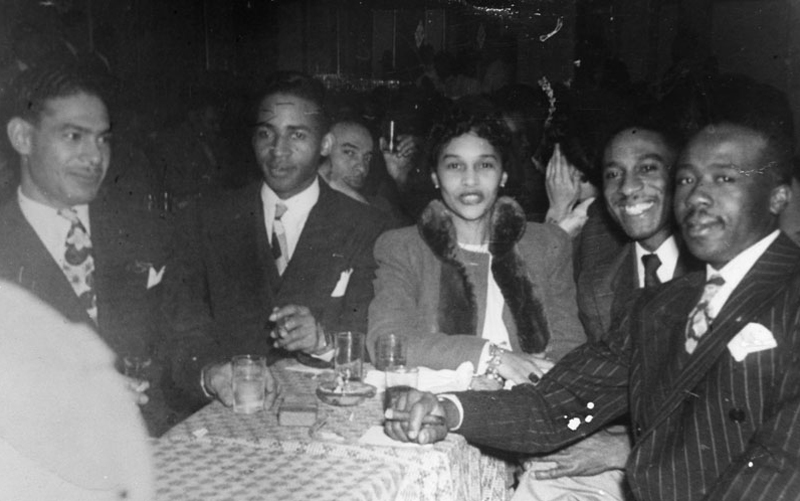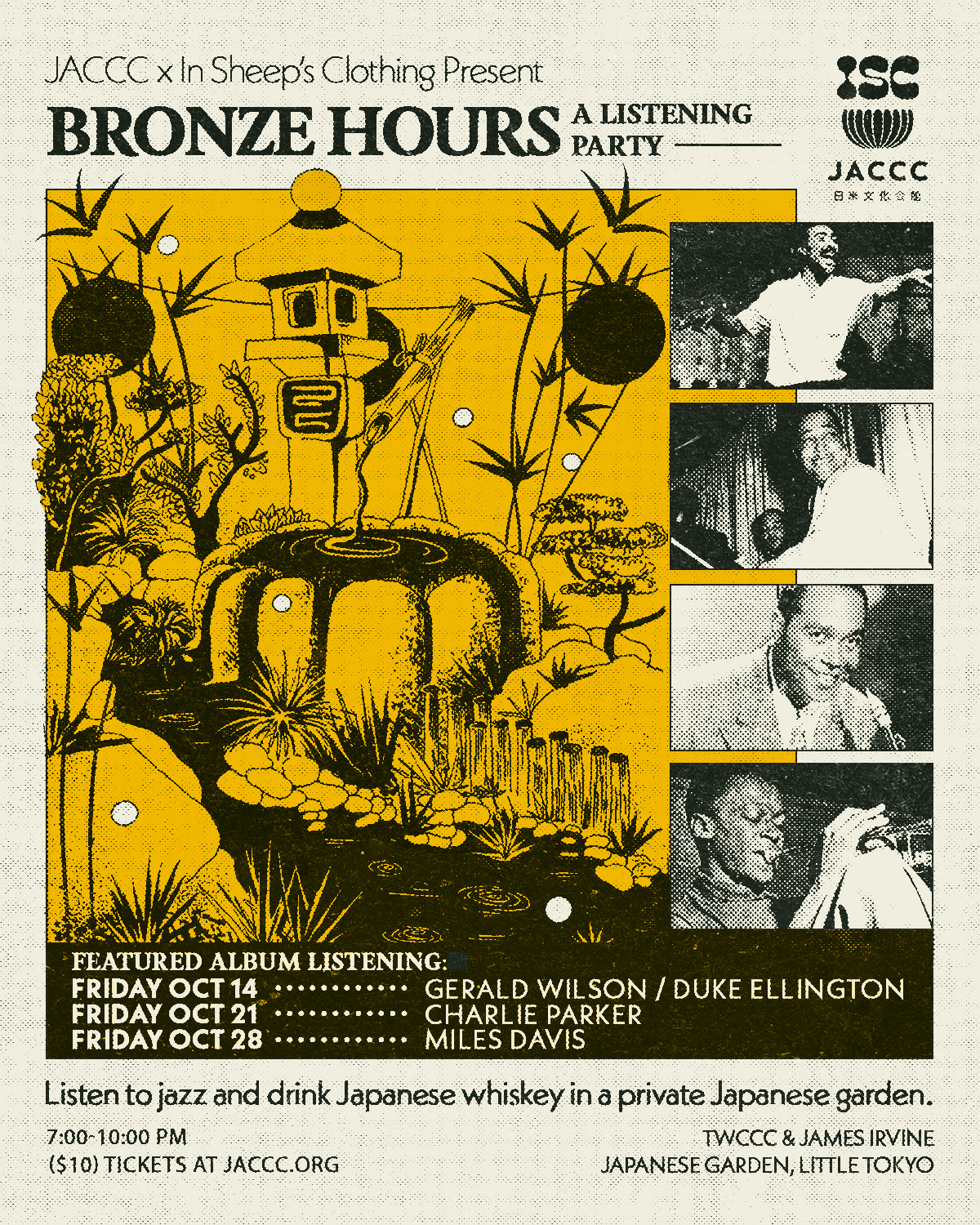Bronzeville

A table at Shepps' Playhouse, a Bronzeville nightclub at 1st and Los Angeles Streets, ca. 1945
(Photograph courtesy Los Angeles Public Library)
In 1942, President Roosevelt’s Executive Order 9066 forcibly emptied Little Tokyo of approximately 7,500 Japanese Americans (JAs), incarcerating them in concentration camps throughout the country’s interior. This left an entire Los Angeles neighborhood empty.
Though Black people were moving to Los Angeles to work in wartime factories, 95% of LA neighborhoods had racist restrictions and Little Tokyo fell within the remaining 5%. An estimated 30,000~80,000 Blacks moved in, initiating the Bronzeville era (1942~1950s).
During Bronzeville, the neighborhood became a major cultural hub for nightclubs, restaurants, and breakfast clubs connected to Black music and jazz. However ownership of buildings remained with Whites, Eastern European Jews, and some californios.
On Dec 18, 1944, the Korematsu v US Supreme Court decision led to the exclusion order being lifted, and Japanese Americans were free to return to Los Angeles starting Jan 2, 1945. By the end of 1946, 60% of the pre-war JA population had returned to LA County.
In the post-war Little Bronze Tokyo era (1945~1950s), 75% of Japanese American returnees lived in crowded hostels, churches, temples, and hotels near Skid Row.
In an effort to co-exist, Bronzeville businessmen held a welcome reception, and Black merchants presented flowers to returning JAs. Kīchi Uyeda opened a five and dime store, the first JA business in Bronzeville, and hired Black clerks. Samuel Evans hired JA waitresses at Bamboo Room, and the Los Angeles Tribune hired 3 JA writers (including short story writer Hisaye Yamamoto) and promoted Black-JA dialogue. Yamamoto’s column “Small Talk” covered her insights into Black culture and exposed Black readers to JA life.
Though JAs re-established businesses in the neighborhood, they had to live elsewhere like Boyle Heights. Black people lived in the neighborhood and had limited housing and employment options.
The end of the Bronzeville era was essentially a combination of different forms of institutional and structural racism.
As the postwar economy contracted, factories laid off Blacks first, and wages did not keep up with inflation. Landlords gave preferential treatment to Japanese Americans, stereotyping them as more desirable, allowing them to buy out Black leases and incentivizing subleases to Japanese Americans.
In 1950, the City used eminent domain to buy the Main, Los Angeles, First, and Temple block for a new police headquarters and Parker Center, which destroyed ¼ of the neighborhood. 3,000 residents were evicted from the block, 90% Black.
Though Black people were moving to Los Angeles to work in wartime factories, 95% of LA neighborhoods had racist restrictions and Little Tokyo fell within the remaining 5%. An estimated 30,000~80,000 Blacks moved in, initiating the Bronzeville era (1942~1950s).
During Bronzeville, the neighborhood became a major cultural hub for nightclubs, restaurants, and breakfast clubs connected to Black music and jazz. However ownership of buildings remained with Whites, Eastern European Jews, and some californios.
On Dec 18, 1944, the Korematsu v US Supreme Court decision led to the exclusion order being lifted, and Japanese Americans were free to return to Los Angeles starting Jan 2, 1945. By the end of 1946, 60% of the pre-war JA population had returned to LA County.
In the post-war Little Bronze Tokyo era (1945~1950s), 75% of Japanese American returnees lived in crowded hostels, churches, temples, and hotels near Skid Row.
In an effort to co-exist, Bronzeville businessmen held a welcome reception, and Black merchants presented flowers to returning JAs. Kīchi Uyeda opened a five and dime store, the first JA business in Bronzeville, and hired Black clerks. Samuel Evans hired JA waitresses at Bamboo Room, and the Los Angeles Tribune hired 3 JA writers (including short story writer Hisaye Yamamoto) and promoted Black-JA dialogue. Yamamoto’s column “Small Talk” covered her insights into Black culture and exposed Black readers to JA life.
Though JAs re-established businesses in the neighborhood, they had to live elsewhere like Boyle Heights. Black people lived in the neighborhood and had limited housing and employment options.
The end of the Bronzeville era was essentially a combination of different forms of institutional and structural racism.
As the postwar economy contracted, factories laid off Blacks first, and wages did not keep up with inflation. Landlords gave preferential treatment to Japanese Americans, stereotyping them as more desirable, allowing them to buy out Black leases and incentivizing subleases to Japanese Americans.
In 1950, the City used eminent domain to buy the Main, Los Angeles, First, and Temple block for a new police headquarters and Parker Center, which destroyed ¼ of the neighborhood. 3,000 residents were evicted from the block, 90% Black.
Sources:
Michihiro Ama, “A Jewish Buddhist Priest: The Curious Case of Julius A. Goldwater and the Hompa Hongwanji Buddhist Temple in 1930s-1940s Los Angeles” in Southern California Quarterly, vol 93 no 2
Hillary Jenks, “Bronzeville, Little Tokyo, and the Unstable Geography of Race in Post-World War II Los Angeles” in Southern California Quarterly, vol 100 no 3
Michihiro Ama, “A Jewish Buddhist Priest: The Curious Case of Julius A. Goldwater and the Hompa Hongwanji Buddhist Temple in 1930s-1940s Los Angeles” in Southern California Quarterly, vol 93 no 2
Hillary Jenks, “Bronzeville, Little Tokyo, and the Unstable Geography of Race in Post-World War II Los Angeles” in Southern California Quarterly, vol 100 no 3
Learn More
The Finale Club - Little Tokyo Historical Society
How 'Little Tokyo' Of Los Angeles Changed Into 'Bronzeville' And Back Again - NPR
Rediscovering L.A.’s Lost Neighborhood of Bronzeville - Los Angeles Magazine
Azusa Street to Bronzeville: The Black History of Little Tokyo - KCET
